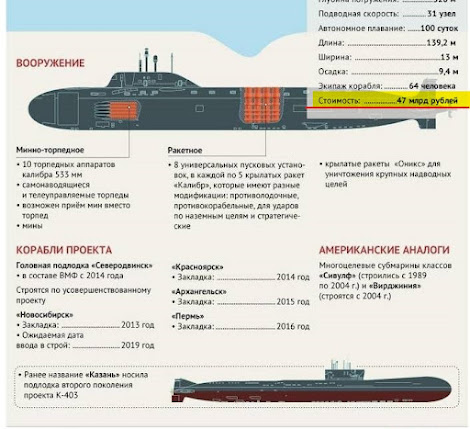... if you follow a direct conversion of currencies. I know, I know, but still. In this case R 8.4 trillion issued for the Russian Navy to the end of this decade converts roughly to $100 billion. Take a look at this, as an example from 2016.
Project 11356 frigate at the signing of the acceptance documents came out at the prices of 2010-11 with R to $ rate then at 30 to 1 ...
... at roughly (let's round it up) R 14, 000, 000, 000 which when divided by 30 gives you a rough price of about $ 467, 000, 000 which is reasonable (more than reasonable) for the frigate of this class with the state-of-the-art AD complex and 3C14 VLS capable of launching all modern Russian cruise missiles, including 3M22 Zircon. Most likely the actual price for this type is somewhere around $400,000,000 and this is for the ship whose strike power in Surface Warfare makes ANY surface combatant in frigate class rather underwhelming.
Now comes the issue of the pr.885M SSGN of Yasen class (all of which are capable of launching hypersonic 3M22 Zircon) and here we have the price range of R 47,000,000,000, but again in prices of 2011-2014, give and take (in Russian).
To not complicate matters, let's assume that the newest (floated out a few days ago) Perm SSGN is around $1 billion give and take. For comparison, latest Virginia-class SSN-800 USS Arkansas (its latest class's Block) will cost already in excess of $4 billion. So, we are beginning to see this "magical" ratio of 1 to 4 or 6 whenever comparing Russian and American technology. Let's omit here venturing into qualitative characteristics.
Now, let's take a look at pr. 22350M ("improved" Gorshkov-class). For some reason WiKi gives the actual cost of the first hull of the class as $250 million. It is unrealistic, especially for the ship class armed with extremely advanced AD suite (Poliment-Redut) and being a carrier of all types of weapons, including Zircon. The likely cost of it is around $500 million, with much larger "Super" Gorshkov cost being around, give and take, $700 to 800 million. Comparison with the US Navy's mainstay Arleigh Burke-class DDGs (Flight III DDG-51) is also rather startling because the cost of a single hull will cost the US Navy in excess of $2.5 billion. Her we make qualitative comparison--DDG-51 is no competitor with ANY (earlier or "super" version) of Gorshkov-class in Surface Warfare. Simple as that, in ship-to-ship engagement DDG-51 will not know what struck it and will not be able defend against the salvo of super-sonic 1,000-kilometer range P-800 Onyx or 1,500-kilometer range hypersonic 3M22 Zircon. Here we arrive to the main point, not only Russian ships are much less expensive than any US main sub and surface combatant, but they are simply much better armed, while being highly competitive in terms of sensor and signal processing suites. In other words--Russian Navy gets much-much more bang for a proverbial buck.
Which brings us to a very rough shopping list through 2030-2032. The white elephant or proverbial 800-pound gorilla. Will Russian Navy get new aircraft carrier(s). No doubt, Admiral Kuznetsov which is now a completely new ship in propulsion, sensors and air wing, will return to the fleet probably this year. Russians are not in a hurry; they just want to do it right. But the question is--what about new ones? Something tells me that Russia may consider couple of the new carriers and those will be nothing like what combined West operates. Each of them will likely run into the $5 to 6 billion range, including proper basing, and that gets us immediately over $12 billion in costs: 100-12 = $88 billion. Still, a lot of dough left. And that is when it all becomes interesting.
Russian Navy plans to procure first Husky (Laika) class subs sometime after 2030. We can only guess what those subs will be, but by the time Russian Navy will be ready to procure the first one, it will have continuation of the pr. 885M SSGNs and, highly likely, yet another "improved" Yasen-class, call it "super" Yasen if you wish and the fleet of these subs will be much larger than officially adopted run of 12 contracted hulls. Maybe 20? Take additional 8, which gives you roughly $8 billion and that gets us: 88-8=$80 billion. Still, a lot of dough. Laika (Husky) class is this unknown which may modify SSGNs construction. But no worries, Lada-class SSKs with AIP are already coming online and they are needed despite improved Kilo's (pr. 636) entering the fleet at a good pace. How many Ladas will be there? Again, the plan is for 12 but likely more. The guess for Lada's price is around $300-400 million.
Per Gorshkovs, the only thing I can say is--many. Especially 64 cell "super" Gorshkov and, eventually, turning into DDG territory. But a rough estimate for 10 "super' Gorshkovs--$8 billion, and don't torture me with all those "Lider" class DDGs--I don't know. And then we enter the territory of Poseidons, underwater drones, newest weapon systems (new hypersonics, new SLBMs et al), additional AD for naval bases, possibly new carrier combat aircraft, complete update of ASW/Patrol aviation and financing of the new R&D among many other things. Mind you, these $100 billion DO NOT include salaries and benefits, those are covered by other programs. But one thing is clear--it is a dramatic boost for Russian Navy which already shapes itself as a mighty alternative to carrier-centric navies of the past and we may only guess how it will look like even 5 years down the road.
In conclusion, again--Perm is NOT the first sub capable of launching 3M22 Zircon. All previous Yasens can also do that, but Perm is the first purposely built for using those hypersonic missiles, even all 32 of them))



No comments:
Post a Comment